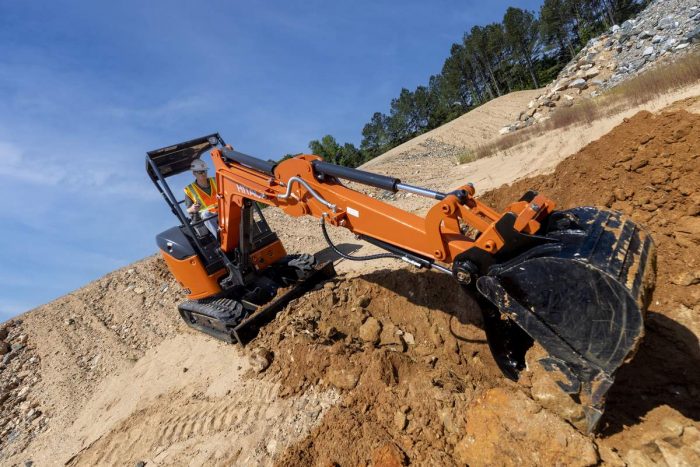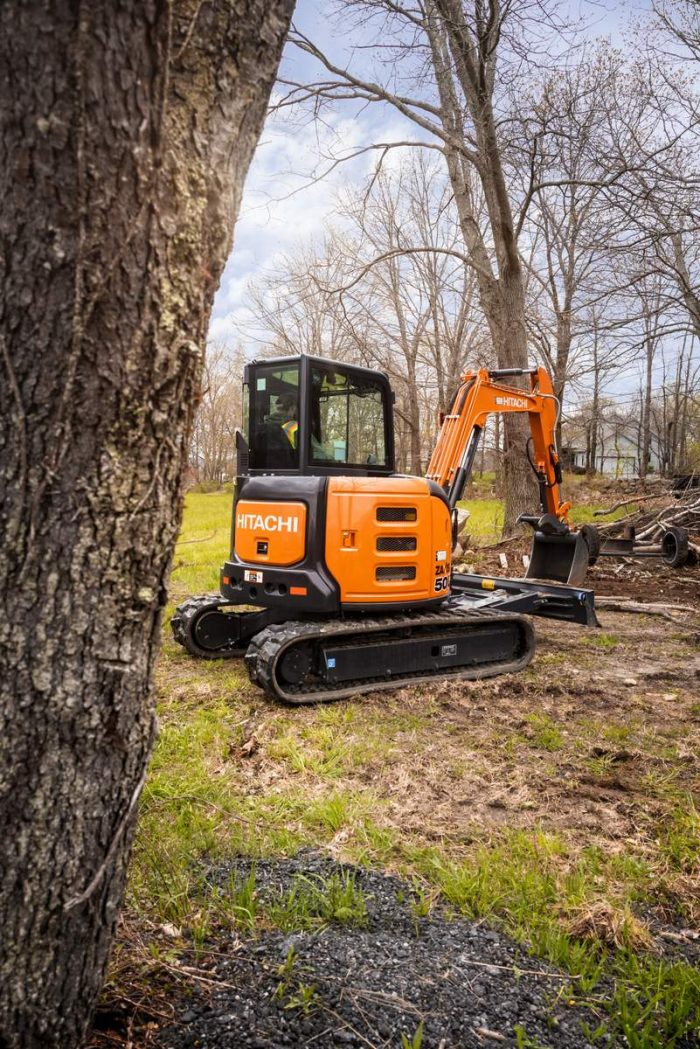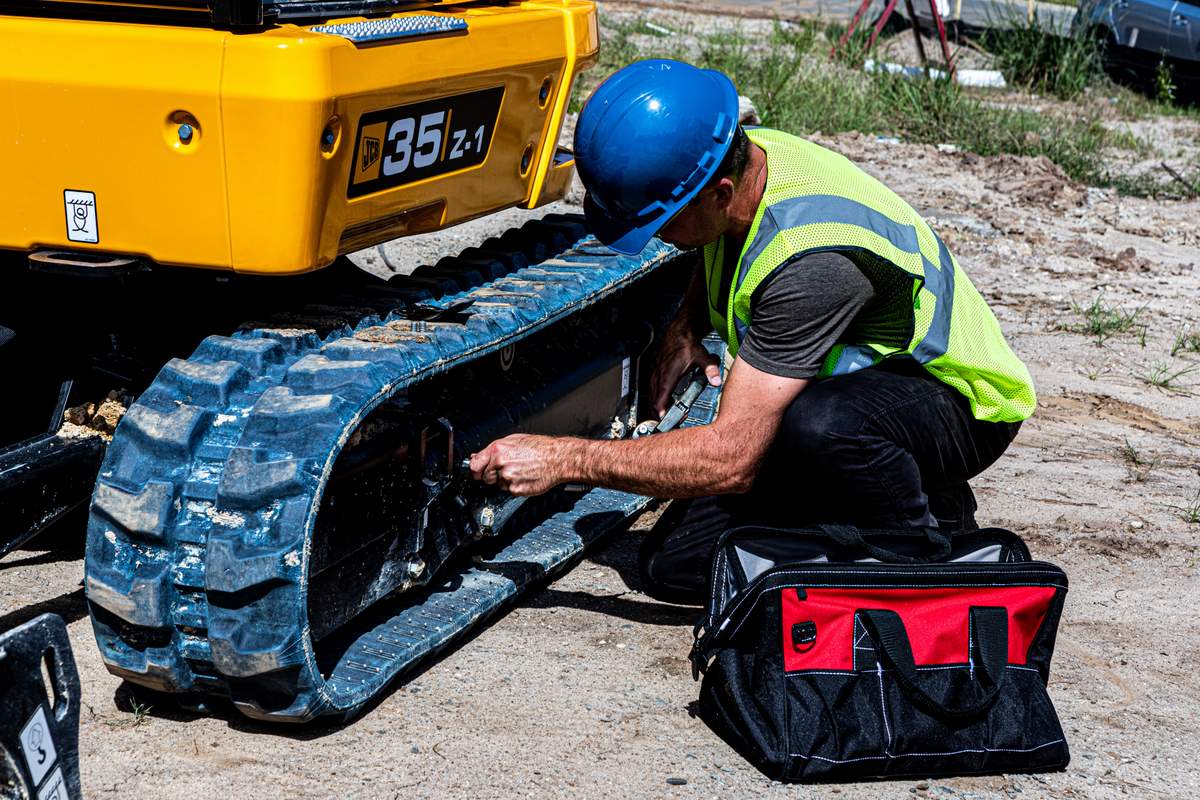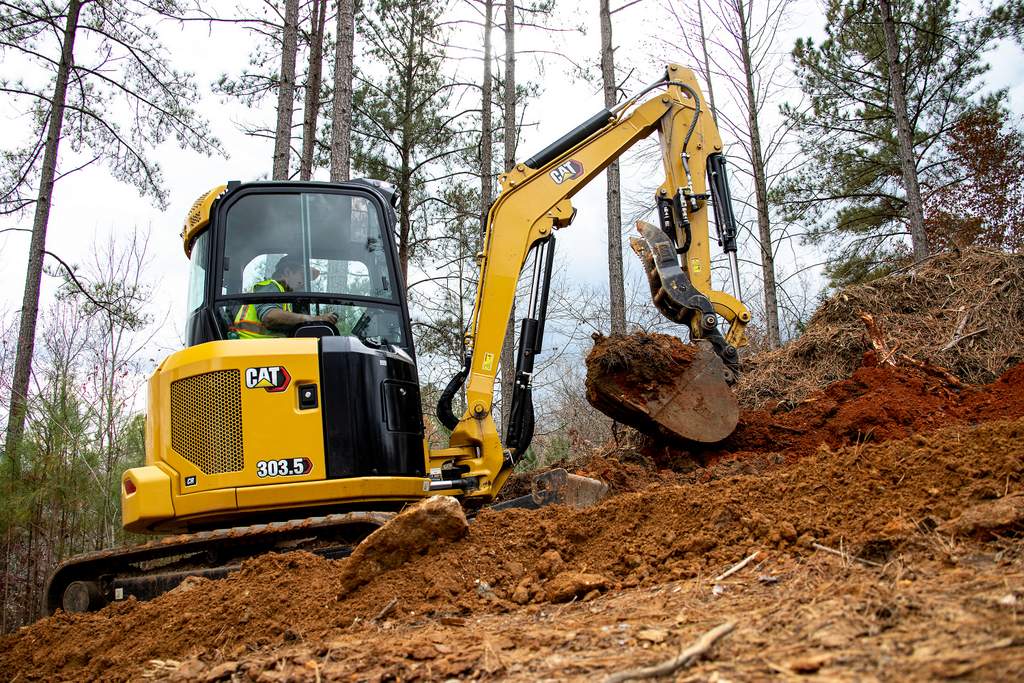Editor at Large: Jetting Down to Georgia to Talk about Hitachi’s Two New Compact Excavators

Japanese excavators have earned a halo of high quality. It’s like Swiss watches or Italian sports cars. My ears perk up when I hear the words in succession. Hitachi is a brand that’s synonymous with excavators. The company actually launched the first hydraulic excavator in Japan back in 1965 — the UH03. The company launched its EX Series of mini excavators in Japan in 1987. Today, the brand is the biggest maker of excavators in the world.
“In many markets globally, Hitachi has 30 to 40 percent market share,” said Simon Wilson, vice president of sales at Hitachi Construction Machinery Americas Inc., speaking at a press event last week in Pine Mountain, Ga. “Japan is still considered the premier market where excavators are designed and engineered. There are a significant number of hydraulic excavator companies based in Japan, and these engineers live and breathe these products, the technology and the construction market. I think you met some of them [pointing to the Hitachi contingent in the room]. Their passion for this product is unrivaled. This is what they do.”
In America, the Hitachi brand has always been tied to John Deere. John Deere and Hitachi have been business partners since the 1960s, working together on distribution, sales and OEM relationships in both the Americas and Asia. Hitachi specifically has supplied John Deere with its excavator lineup since the early ‘80s, but their partnership is changing. The two companies’ 30+ year manufacturing joint venture (see the timeline below) ended in March. John Deere has acquired full ownership of three Deere-Hitachi factories and has begun new license and supply agreements with the Japanese excavator specialist. On its end, Hitachi is now entering the American markets (both North and South) with a new sales and marketing force in 2022 and new Hitachi-branded products, including two new compact excavators and six more in the future.
“In North America [in the past], a significant portion of Hitachi machines were manufactured under the John Deere badge and marketed that way,” explained Wilson. “But over the last five or six years, the discussion started to change and we said, ‘Maybe we want to go our separate ways.’ It’s a very difficult kind of discussion. It wasn’t bad. It was really much more of, you know, there are different things that each of us want to do. The economics changed and where the businesses were going. John Deere was talking about where they wanted to go and Hitachi was talking about where it wanted to go globally, as the largest manufacturer of excavators in the world.”
The end result for Hitachi will be a lot more Hitachi-branded excavators and wheel loaders on dealer lots and jobsites in America in 2022 and beyond. The company has secured 25 dealer groups (around 250 locations) and has hired 150 employees in North and South America in the last six months. “And we’re not finished yet,” added Wilson. Nope. Hitachi Construction Machinery Americas is gearing up for the biggest year in its existence. Things are just getting started.
Joint Venture Timeline
In 1988, the companies started the Deere-Hitachi manufacturing joint venture to produce excavators in Kernersville, N.C.
In 1998, Deere-Hitachi expanded the relationship to include the production of forestry swing machines at Deere-Hitachi Specialty Products in Langley, BC.
In 2001, John Deere and Hitachi combined their marketing and distribution efforts in the Americas.
In 2011, excavator manufacturing was expanded with the addition of the Deere-Hitachi Brazil factory in Indaiatuba, Brazil.
In March 2022, John Deere and Hitachi end their joint venture manufacturing and marketing agreements. John Deere has acquired full ownership of three Deere-Hitachi joint venture factories and has begun new license and supply agreements with Hitachi Construction Machinery Americas Inc.
Let’s Talk About Those Two New Compact Excavators
Hitachi Construction Machinery Americas or HCMA is headquartered in Newnan, Ga. Hitachi compact excavators are manufactured in Banshu, Ryugasaki, Tierra and Hitachinaka, Japan. The company teased a total of eight compact excavators coming to America at the press event last week (held at the beautifully expansive Callaway Resort and Gardens), ranging from 1.7 to 8.5 metric tons. Right now, there are two units available on U.S. dealer lots — the ZX26U-5N and ZX50U-5N.
“You’re going to hear me talk a lot about efficiency, reliability and safety,” explained Rob Orlowski, HCMA director of product management and engineering. “Those are some keys that we design into all of our equipment. Let’s start with the beauty here — the 26U — ideal for trenching, residential, landscaping, those types of applications. It’s got a reduced tail swing. It’s a very compact machine, so you can get into tight spaces. If you’re by a house or you have to work along the foundation, parallel to the house, you can get into those tight spots and not worry about the tail swing. It’s a 5,560-lb [operating weight] machine, 20-hp machine, very versatile.”
The ZX26U-5N is nimble. It’s only 4 ft, 11 in. wide, so it’s perfect for cramped urban construction and easy transport from jobsite to jobsite. The unit has a maximum reach of 15 ft, 2 in. and a dig depth of 8 ft, 6 in. There’s a lot to look at here: integrated dozer blade; full hydraulic pilot controls; one-way/two-way selector valve accommodating breakers and grapples; and an easy-to-access control pattern switcher that’s in a compartment beneath the seat (I’m a backhoe pattern guy, so this is important).
Mini excavators are making big waves on jobsites all over North America. Click here for the latest news on these machines and the companies that make them.
Fuel efficiency is enhanced with a Tier 4 Final compliant, direct-injected Yanmar engine that produces 20 net hp, meaning no aftertreatment is necessary and that’s always a plus. There’s an auxiliary function lever (AFL) available with an analog switch, trigger switch and horn for running attachments such as a breaker.
“Our hydraulics are tried and tested,” said Orlowski. “We’ve got a lot of experience out in the market. Also, the cab is very spacious on this small machine. The travel pedals can be folded back. I have size 13 quadruple E shoes, and I can get in there. We’ve also got a low noise cab. You’ll also see the visibility, whether we have a cab or [ROPS], visibility is superior.”

A seat with suspension and adjustable armrest adds to the operator’s comfort level. When it comes to maintenance, Hitachi engineers worked to ensure easy access, said Orlowski. The ZX26U-5N provides ground-level access to daily maintenance points, grouped behind easy-access covers. The large engine cover slides open vertically for access when the machine is working in a confined area. The design of the cooling package makes cleanout a breeze. It’s located behind a one-touch open cover. Hitachi has also made it easier to replace damaged glass in the cab.
“We went to flat glass because it’s less expensive to repair,” noted Orlowski. “If you bust something out, the customer wants to repair, especially on these smaller machines, they want to repair it inexpensively. Flat glass really allows for that.”
In a larger format, the Hitachi ZX50U-5N compact excavator offers many of the same advantages — flat glass, easy maintenance, reduced tail swing, auxiliary function lever, two-way hydraulic valve — in a 5-metric-ton class. The ZX50U-5N excavator has an operating weight of 10,560 lbs, max reach of 19 ft, 7 in. and a dig depth of 11 ft, 7 in. The unit has an angled backfill blade, allowing the excavator to fill or grade while angling 25 degrees.
A Tier 4 Final compliant, direct-injected Yanmar engine produces 36.3 net hp. The ZX50U-5N has two operational modes: The power mode provides higher engine speeds for most general digging work, while the economy mode reduces engine speed for lighter digging jobs. The excavator also uses the Hitachi Triple H (HHH) hydraulic system, which enables combined operations by adjusting the optimal flow rate for all the actuators. Also…
“It’s got the option of steel tracks or rubber pads,” said Orlowski. “Depending on what they’re doing, they may want some different tracks for it.”

The ZX50U-5N operating experience is enhanced with a 3.5-in. LCD monitor, which keeps the operator informed of vital information while allowing fingertip control of several functions, including auto shutdown and those power and economy modes we just mentioned. The screen is black and white.
“Why do you want black and white for this? Because if you don’t have a cab and you’re in low morning light or at night, the black and white is easier to see in the sunlight,” said Orlowski.
The ZX50U-5N is built to the same durability standards as larger Hitachi excavators. Oil-impregnated HN bushings are used on the boom, arm and bucket joints for increased durability. Heavy-duty X-frames provide a rock-solid base that resists material and dirt buildup. A single-pin swing post increases the structural integrity of the digging components. A large fuel tank, 500- and 2,000-hour engine and hydraulic oil service and 500-hour greasing intervals enable these excavators to work long hours between scheduled service intervals. And when it comes to service, the operator station on the ZX50U-5N tilts forward 50 degrees, simplifying access to the swing motor, hydraulic control valve, engine starter motor and alternator.
The ZX50U-5N and ZX26U-5N are two cool new units to the American marketplace, which is craving more mini excavators right now.
“I’m really glad that we picked these models to release,” said Orlowski. “I can’t wait to be able to introduce the other machines going forward.”
Hitachi’s Future Plans

As mentioned, during the press event Hitachi noted it has plans to launch eight models of compact excavators to the American dealer lot. The company also currently has two compact wheel loaders available for U.S. contractors. Hitachi will continue to hire more internal staff and grow its dealer network in the Americas. It’s next big move?
“The next big phase for us is Latin America,” said Wilson. “The ramp up right now is the initial build. Then we’ll be building out and completing some of the product lineup — more niche areas, different segments. There’s a lot of that work behind the scenes. So, there’s going to be a lot more in 2023 on the product side. 2022 is all about the distribution and the initial launch.”
Those new products might even include an electric excavator. Maybe?
“Sustainability is a big piece of the picture, and you’ll see this with new products coming — electric products and some alternative powered machines,” said Wilson. “CONEXPO will be a great place to look at some of that new technology as we go forward. It’s good for the customer. It’s good for the environment. It’s good for where we are, and that includes a significant focus on carbon reduction, within our mining segment for example. Electrification is a massive undertaking. Next week, we’ll be meeting with some groups out of Latin America with new mine projects that are 100 percent electrified. It’s another example where we’re really taking the power of all of our parent company and our connections in it and really moving it to the next level.”
Keith Gribbins is publisher of Compact Equipment.
Hitachi Expands Manufacturing Plant to Meet Growing Demand for Compact Products

Demand for compact machinery continues an upward trajectory as the COVID-19 pandemic subsides and the resultant recovery takes hold. In particular, steady housing starts are expected to drive growth in the North American market, where Hitachi Construction Machinery Americas Inc. (HCMA) started its full-scale business expansion in March 2022. Taking a proactive approach to meet this future demand, Hitachi Construction Machinery Co., Ltd. will increase the production capacity for compact products such as excavators and wheel loaders produced at the Shiga Works facility of its consolidated subsidiary, Hitachi Construction Machinery Tierra Co., Ltd. The Shiga Works facility is forecast to produce approximately 30% more units by FY 2025 compared to the number of machines produced in FY 2021.




